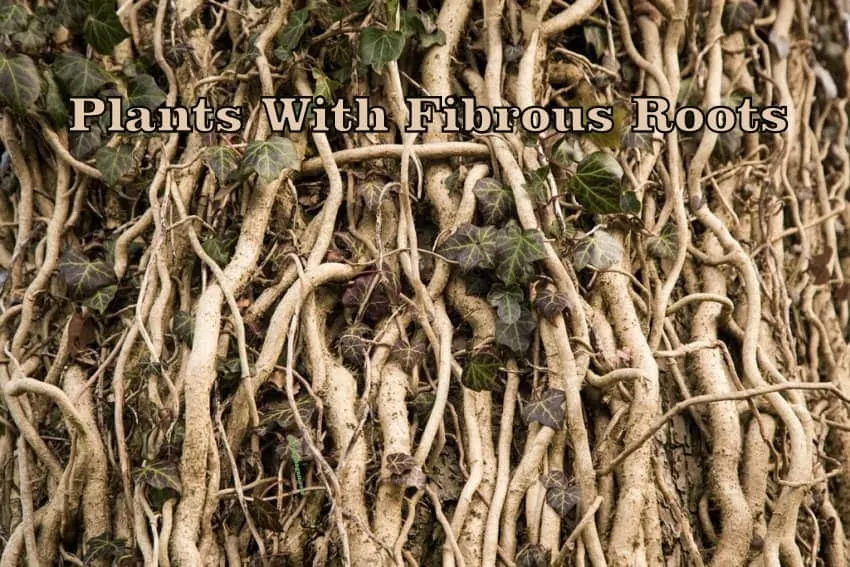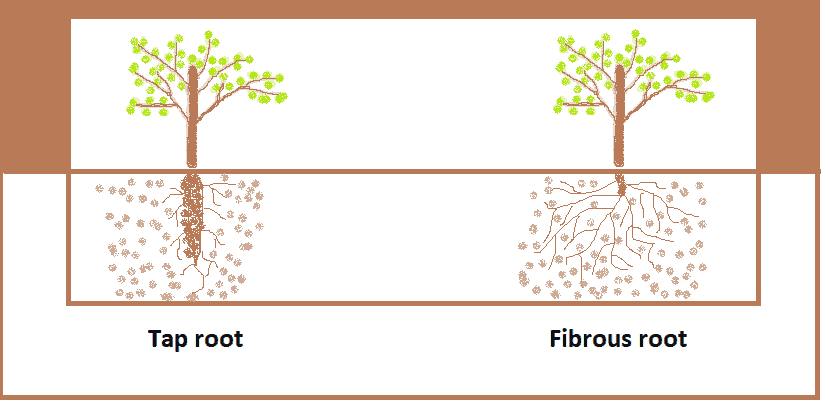Have you ever tried to pull out weeds from your potted plant? Isn’t it tough? Sometimes it is harder than it looks.
Now imagine if you try pulling out a plant from the pot. It holds the soil firmly. so where does this strength comes from?
Obviously, it is the root that provides the strength to the plant. The roots of the plant help the plant to anchor to the soil.
They help the plant to retain water and play a vital role in the growth and development of a plant. When we use some force and pull out some plants, we see plants having different root structures.
So what are the different types of root structures that we can see?
Some plants like grass have in form of a bunch very close to the stem which spreads laterally. Whereas plants like radish have one long vertical root.
Thus it can be clearly understood that there are two main types of root systems.
- Taproot
- Fibrous root

Dicots have a tap root system which is the primary root system, while monocots have a fibrous root system that looks like fiber, and is also known as an adventitious root system.
Taproot:
A taproot system like in a radish plant has a main root that grows down vertically, from which many smaller lateral roots arise or grow.
A single central root system is the main characteristic of the taproot system. These roots are fed by several thin root hairs.
Read my latest post on 20 Plants with Taproots- Know the Root System.
Fibrous root:

A fibrous root system like in a grass plant is opposite of the taproot system which is usually found in monocots.
These types of roots don’t have any central root. So it is very difficult to identify the main root is this type of root system.
What is fibrous root?
It is a bushy root structure formed by moderately thin growing branches from the stem.
It is found that many plants begin growing with a tap root system. Eventually, after a few years, they look more like a fibrous root network with wide spreads into the soil.
The network of fibrous roots grows close to the surface of the ground. The plants with fibrous roots are not very deep-rooted.
We can observe several modifications in plants with fibrous roots. Some of these modifications are really interesting.
Modifications of Fibrous Roots
- Adventitious roots: Sometimes the fibrous roots collect the food of the plant and store them in it resulting to fleshing adventitious roots
These adventitious are further divided into two types:
- Tuberous roots
- Fasciculate roots
A tuberous root is the one in which each of the roots has a swollen structure and they tend to occur singly.
The well-known example would be the Sweet potato plant. It has fibrous roots which are of tuberous fleshing adventitious roots where each root tend to be swollen singly thus storing food into it
Whereas fasciculate root is the ones where the root stores food in a cluster and are very close to the stem.
- Prop Roots:
The second modification that occurs in fibrous roots is the prop root stem. This one appears in the form of large horizontal branches and acts like large pillars.
This modification is mostly seen in the banyan tree. When a big tree like banyan grows horizontally. It becomes huge and branches get so heavy that it is very difficult to hold steady.
It cannot survive with the help of a single root structure.
So to support the plant, several root-like structures grow from the stem. These roots grow vertically downwards and touch the soil acting as a pillar and thus supporting its weight.
Do you know what roots above the ground known as? What do you call a system of the root above ground?
Keep reading… You will get the answer in a different plant with fibrous roots
- Stilt Roots:
The third type of modification seen is known as the stilt roots. These stilt roots are the ones that appear from the basal nodes near the soil.
Roots from the stem go down into the soil giving extra support to the plant. These type of roots are seen in plants which attain great height with a thin stem. Therefore they require extra support which these stilt roots provide them
Now let us read more about different plants with fibrous roots
Some Plants with Fibrous roots:
Banyan tree:
A very well know tree which grows horizontally and is a huge plant.
Due to its huge size, it cannot survive with the help of a single root structure.
So in order to support the plant, several root-like structures grow from the stem. It grows vertically downwards which reaches and enters the soil acting as a pillar and thus supporting the growth of a banyan tree.

The roots that are found above the ground are known as Aerial Roots
Do you know?
The banyan tree is the national tree of India and is considered sacred. Another interesting fact about the Banyan tree is that in the ideal conditions these trees can live for more than 1000 years. They are literally Immortal.
So it is possible that a banyan tree seen today may have lived since your great grandfather or even earlier than that of his grandfather.
Sugarcane:
Yes, you heard it right; the sugarcane plant also has fibrous roots. They have stilt roots that appear from the basal nodes near the soil.
The root growing from the stem, go down into the soil giving extra support to the plant. Usually, these roots grow only from few lower nodes near the soil.
These types of roots are seen in sugar cane plants when they attain great height. A thin stem requires extra support to survive and grow which is provided to the by stilt roots.
The perfect temperature for the cultivation of sugarcane plant is 27° Celsius. It requires a rainfall of 100 cm to 175 cm for its ideal production. Black soil is best for sugarcane.
Sweet potato:
Sweet potato plant has fibrous roots that modify into tuberous fleshing adventitious roots. Each root grows and swells singly for storing food into it.
Do you know where did sweet potato originally come from? It originated originally in Central or South America. Latter it reaches the other parts of the world.

Asparagus:
Asparagus plant has fibrous roots that are modified into fleshy adventitious root which appear in clusters.
They are tuberous root which becomes thick in cluster form. Starch as food is stored in them. They occur in clusters at the base of the stem. These roots are not very deep.
Screw pine:
Screw pine (Pandanus) just like sugarcane, It has stilt roots that appear from the basal nodes near the soil.
They are also tall plants with a thin stem. These types of roots help plants like screw pine which has attained great height giving it the required extra support.
Screw pine is mainly found in coastlines of the Atlantic, Indian and Pacific Oceans and is cultivated for its edible fruit.
Dahlia:
Dahlia is a plant with a tuberous root that becomes thick due to the storage of starch as food.
They occur in clusters at the base of the stem. It has a modification in its fibrous roots which leads to storing starch in the roots in the form of clusters.
Dahlia is native to Mexico and Central America and has 35 different kinds of species.
Maize (Zea mays):
Similar to sugarcane and Screw pine maize has stilt roots that appear from the basal nodes near the soil.
They are also tall plants with the thin stem so the roots are important to provide extra support to the plant. These types of root help plants by giving them the required extra support to stand firmly.
It is commonly known as corn and is found worldwide. Maize is native to Australia, Canada, and the United States.
Grass:
The root and the branches of grass are thin and thread-like structures that give it a shape of fibrous roots.
The fibrous roots of grass do not penetrate deep into the soil. They are called surface feeders because they remain near to the surface of the soil.
And as we all know that grass can be found anywhere and everywhere. It (Including all Grass) has about 12,000 species in the world.
Wanna know more interesting facts about Grass- read this: – Is Grass a Vegetable? Surprising Garden facts.
Orchis/Orchids:
The orchids or orchid plants also have fibrous roots. These roots are fleshy and thickened like the palm of the human hand.
They similarly possess finger-like outgrowths due to their modification.
They are mainly found in southern Central America, northwest South America
- Basella & Portulaca
Basella is an edible plant popularly known as spinach in India has roots swollen at regular intervals like beads of a necklace.
It can be easily found in central and western Asia.
Portulaca is a beautiful flower for the summer season. These plants do have fibrous roots. you can read more details about Portulaca.
- Money plant (Photos):
Yes, the commonly found money plant or (Photos) has Clinging or Climbing Roots.
These are non-absorptive adventitious roots that are found in climbers that help them in climbing to its support.
The clinging roots penetrate the cracks or fissures of the support and help the plant to grow.
Some other plants with Fibrous roots are– Banana, Maize, Onions, Garlic, Bamboo and many more that I missed.
Fun Fact: – Roots of a plant are not green. Do you know why??
: – Because the cells of the roots do not contain chlorophyll.
Final Words
I hope you like this post. Please comment on your queries and suggestions. If you know more plants with fibrous roots then let me know. I will include those in the article.
Stay tuned for the next post. Till then Enjoy reading, Keep gardening. Live the Green!

Grasses and bamboo propagate by ‘rhizomes’ and do not form tap roots. In addition, carrots form tap roots and yet they develop feeder roots as they mature. When you say that fibrous roots enlarge and form structures, it would be great to clarify whether this relates to their identity as monocotyledon or dicotyledon plants. Why does the turnip store fuel in its tap root being a dicot when grasses have no such storage structure then orchids have storage roots but they are not tap roots? Should we just agree that biological terms are designed to be morphed and modified to suit the situation?